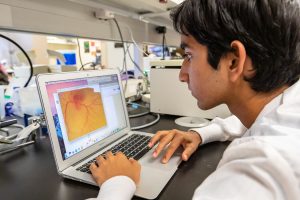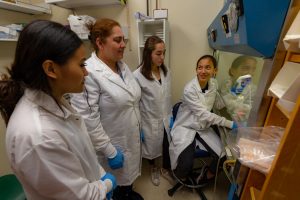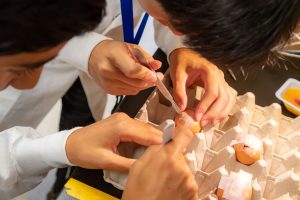Instructor(s):
Dr. John Lowengrub, Mathematics, UCI
Dr. Felix Grun, Chemistry, UCI
Prerequisites: High School Biology, Algebra II or Integrated Math II, and computer literacy; interest in using computational tools and software to study and analyze biological phenomena
General Description:
Students will explore, through lectures and virtual laboratory practicums, the biological mechanisms regulating growth of living cells and their cooperative interactions in tissues. Letter topics will include descriptions of the cell cycle and its control points, signal transduction pathways in growth and development, genetic mutations involved in carcinogenesis and limiting parameters on tumor growth. Students will also learn about the applications of cutting-edge analytical instruments, e.g., confocal fluorescence microscopes. For laboratory segments, students will learn about how simple model organisms (Xenopus frog eggs, Hydra) and tissue culture experiments are used to study aspects of normal cell behavior in development (rapid cell division, morphogenesis and pattern formulation). The experimental data will be compared to the results from mathematical models for growth control, differentiation and morphogen signaling developed in the mathematical biology course that are relevant to tumor biology.
Course 1 Description- Mathematical Biology: Modeling of Tissue and Tumor Growth
The biological sciences are entering a new era in which scientific advancement requires quantitative solutions to large-scale and complex problems. In this course, we will focus on mathematical modeling of tissue and tumor (abnormal tissue) growth. We will start with very basic models and provide prescriptions as how to increase the level of sophistication and thus the realism of the models. As the biological mechanisms of growth are introduced in the Biology course, we will present mathematical models of those processes and also introduce computational algorithms that can be used to simulate the models on the computer. We will discuss applications ranging from tissue engineering to studying the growth of tumors such as melanoma (skin cancer), glioma (brain tumor) and neuroblastoma. Further, we will discuss the prevention, diagnosis and treatment of cancer in a clinical environment.
Course 2 Description- Growth Control in Normal and Abnormal Tissues
This course focuses on the processes that regulate the normal growth of cells, how this regulation can be perturbed during the progression to tumor formation and cancer, and how information about these processes can be used to develop strategies for therapeutic intervention. Although modern biology has made tremendous progress, much research work remains to fully understand how complex systems are constructed. This understanding is essential to allow for rational development of novel treatments for many human diseases including cancers.


